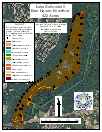Lake Saltonstall, East Haven
2004 Aquatic Plant Survey Map of Lake Saltonstall
Interstate 95 runs past the southern end of 422-acre Lake Saltonstall, but the rest of the lake is surrounded by forest. The lake and the watershed are owned by the South Central Connecticut Regional Water Authority, which limits access and regulates boating and fishing activities. Private boats are prohibited, but boats may be rented from the water authority at the lake, and small motors may be used if they are sterilized. Maximum depth in the lake is 113 feet, and mean depth is 41 feet.
A total of 13 aquatic plant species were found during a July 2004 survey of Lake Saltonstall. Eurasian watermilfoil (Myriophyllum spicatum) and coontail (Ceratophyllum demersum) were the most abundant species, occurring in a distinctive ring around the lake, extending from the shore to a depth of 12 feet. Vegetation extended further from the shore on the reservoir’s eastern side because of the much more gradual slope. It appeared that the Eurasian watermilfoil, an invasive species, was more abundant in water 10 feet deep or less and that coontail was most abundant in water 10 to 12 feet deep.
The eastern side of the lake had multiple patches of water smartweed (Polygonum amphibium), primarily at the southern and northern ends. Several patches of southern naiad (Najas guadalupensis) also were found in these areas. Small pondweed (Potamogeton pusillus) and eelgrass (Vallisneria americana) were found in one small patch with slender naiad (Najas flexilis), coontail, and Eurasian watermilfoil in the northeastern part of the lake. Sago pondweed (Stuckenia pectinata) was found in a patch in the middle of the eastern side, in water approximately 10 feet deep, and small patches of water smartweed and the invasive curlyleaf pondweed (Potamogeton crispus) were recorded in the shallow mouth of the Farm River.
Eurasian watermilfoil and coontail were abundant along the shore on the western side of the lake, and patches of other species were more numerous. Chief among these were water smartweed and sago pondweed, although patches of small pondweed also were recorded. In the southern end of the lake, coontail became more abundant than Eurasian watermilfoil. Vegetation was much more sparse on the west side of the lake because the rocky bottom sloped steeply.
| Species recorded in our 2004 survey of Lake Saltonstall. Scientific Names *Invasive Species |
||
| Clasping-Leaf pondweed | Horned pondweed | Southern naiad |
| Coontail | Minor naiad* | Water smartweed |
| Curlyleaf pondweed* | Needle spikerush | Western waterweed |
| Eelgrass | Sago pondweed | |
| Eurasian watermilfoil* | Small pondweed | |


